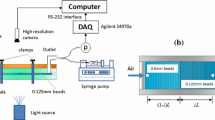Abstract
Counter-current spontaneous imbibition (COUCSI) in porous media is driven by capillary forces. Capillary action results in a high capillary imbibition pressure at the imbibition front and a low capillary drainage pressure at the outlet face. It is the difference between these two pressures that draws in the wetting phase and pushes out the non-wetting phase. A technique for measuring the capillary pressure at an imbibition front under restricted flow conditions has been developed and applied to Berea sandstone with a range of permeabilities. In the experiments, brine was the wetting phase and refined oil was the non-wetting phase. One end face of a sandstone core was butted to a short section of a finer-pored rock. The composite core surface was then sealed, apart from the end face of the low-permeability segment. A connection to a pressure transducer was set in the opposite end face of the core. Initially, the main core segment was filled with oil. In most cases, the finer-pored segment was filled with brine. Imbibition was started by immersing the core in brine. The purpose of the finer-pored segment was to prevent the escape of non-wetting phase from the open face. For some tests there was an initial period of co-current spontaneous imbibition (COCSI) created by allowing production of non-wetting phase through an outlet tapping in the sealed end face. The outlet was then connected to the transducer and the imbibition changed to COUCSI. There followed an increase in the monitored end pressure to a maximum as fluid redistributed within the core. For the tests in which the fine-pored segments were pre-saturated with brine, even without an initial period of co-current imbibition, limited invasion of the main core segment by brine resulted in an asymptotic rise of the end pressure to a maximum as the imbibition front dispersed. To confirm that the dispersing front did not reach the dead end of the core, the distance of advance of the wetting liquid was detected by a series of electrodes. The maximum value of the end pressure provides an estimate of the capillary pressure at an imbibition front for COUCSI. The maximum capillary pressure generated by the invading fluids ranged from 6.6 kPa to 42 kPa for sandstone with permeabilities between 1.050 (μm)2 and 0.06 (μm)2.
Similar content being viewed by others
Abbreviations
- D :
-
Core diameter (m)
- K :
-
Permeability to air (m2)
- L c :
-
Core length (m)
- P c :
-
Capillary pressure (Pa)
- P c,b :
-
Capillary back pressure (Pa)
- P c,f :
-
Capillary pressure at the imbibition front (Pa)
- P end :
-
Pressure measured at the dead end (Pa)
- P nw :
-
Pressure in the non-wetting phase (Pa)
- P nw,f :
-
Pressure in the non-wetting phase at the front (Pa)
- P w :
-
Pressure in the wetting phase (Pa)
- P w,f :
-
Pressure in the wetting phase at the front (Pa)
- \({{\bar{S}_{\rm {w}}}}\) :
-
Average WP saturation
- x :
-
Fractional distance reached by the front along the main core segment
- σ :
-
Interfacial tension (N/m)
- φ :
-
Porosity
- Fab:
-
Front at boundary
- WP:
-
Wetting phase
- NWP:
-
Non-wetting phase
- COCSI:
-
Co-current spontaneous imbibition
- COUCSI:
-
Counter-current spontaneous imbibition
References
Blunt M.J.: Flow in porous media—pore-network models and multiphase flow. Curr. Opin. Colloid Interface Sci. 6, 197–207 (2001). doi:10.1016/S1359-0294(01)00084-X
Handy L.L.: Determination of effective capillary pressures for porous media from imbibition data. Pet. Trans. AIME, (T.P. 8109) 219, 75–80 (1960)
Leverett M.C.: Capillary behaviour in porous solids. Trans. Am. Inst. Min. Metall. Eng. 142, 152–169 (1941)
Li Y., Laidlaw W.C., Wardlaw N.C.: Sensitivity of drainage and imbibition to pore structure as revealed by computer simulation of displacement process. Adv. Colloid Interface Sci. 26, 1–68 (1986). doi:10.1016/0001-8686(86)80014-8
Li Y., Ruth D., Mason G., Morrow N.R.: Pressures acting in counter-current spontaneous imbibition. J. Pet. Sci. Eng. 52, 87–99 (2006). doi:10.1016/j.petrol.2006.03.005
Morrow N.R., Mason G.: Recovery of oil by spontaneous imbibition. Curr. Opin. Colloid Interface Sci. 6, 321–337 (2001). doi:10.1016/S1359-0294(01)00100-5
Rapoport L.A.: Scaling laws for use in design and operation of water–oil flow models. Pet. Trans. AIME, (T.P. 4121) 204, 143–150 (1955)
Ruth D.W., Li Y., Mason G., Morrow N.R.: An approximate analytical solution for counter-current spontaneous imbibition. Transp. Porous Media 66, 373–390 (2007). doi:10.1007/s11242-006-0019-7
Author information
Authors and Affiliations
Corresponding author
Rights and permissions
About this article
Cite this article
Li, Y., Mason, G., Morrow, N.R. et al. Capillary Pressure at the Imbibition Front During Water–Oil Counter-Current Spontaneous Imbibition. Transp Porous Med 77, 475–487 (2009). https://doi.org/10.1007/s11242-008-9272-2
Received:
Accepted:
Published:
Issue Date:
DOI: https://doi.org/10.1007/s11242-008-9272-2




